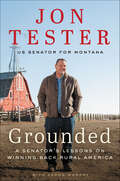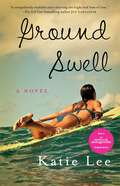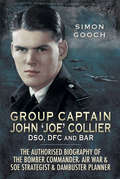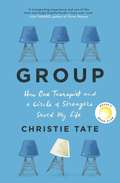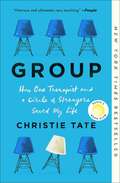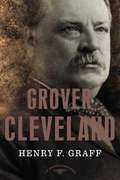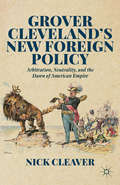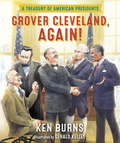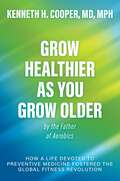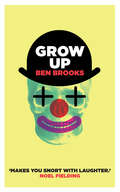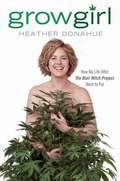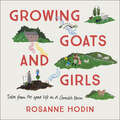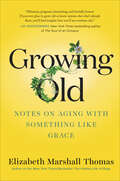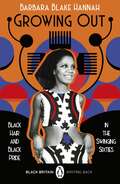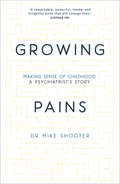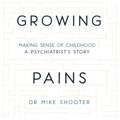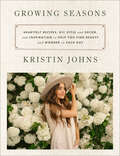- Table View
- List View
Grounded: A Senator's Lessons on Winning Back Rural America
by Jon Tester Aaron MurphyAn inspiring and eye-opening memoir showing how Democrats can reconnect with rural and red-state voters, from Montana’s three-term democratic senatorSenator Jon Tester is a rare voice in Congress. He is the only United States senator who manages a full-time job outside of the Senate—as a farmer. But what has really come to distinguish Tester in the Senate is his commitment to accountability, his ability to stand up to Donald Trump, and his success in, time and again, winning red state voters back to the Democratic Party. In Grounded, Tester shares his early life, his rise in the Democratic party, his vision for helping rural America, and his strategies for reaching red state voters. Leaning deeply into lessons on the value of authenticity and hard work that he learned growing up on his family’s 1,800-acre farm near the small town of Big Sandy, Montana—the same farm he continues to work today with his wife, Sharla—Tester has made his political career a testament to crossing the divides of class and geography. The media and Democrats too often discount rural people as Trump supporters; Tester knows better. His voice is vital to the public discourse as we seek to understand the issues that are important to rural and working-class America in not just the 2020 election but also for years to come. A heartfelt and inspiring memoir from a courageous voice, Grounded shows us that the biggest threat to our democracy isn’t a president who has no moral compass. It’s politicians who don’t understand the value of accountability and hard work. Tester demonstrates that if American democracy is to survive, we must put our trust in the values that keep us grounded.
Groundswell
by Katie Lee"If you liked Eat, Pray, Love, then read Groundswell." —US Weekly (Essential Summer Read selection) A "compulsively readable novel charting the highs and lows of love" (Jen Lancaster) about a young woman recovering from divorce who finds healing—and romance—through surfing.A butterfly flaps its wings in New York City...and a groundswell forms in Mexico. Sometimes the biggest ripples come from the smallest events. Like the day that novice PA Emma Guthrie walks into world-famous movie star Garrett Walker&’s trailer. When she walks out, she&’s on her way to becoming Mrs. Emma Walker, trading her jeans and flip-flops for closets full of Chanel and the start of a successful screenwriting career. But when an incriminating text message throws her marriage into question, Emma flees New York City for a sleepy coastal town in Mexico. Here, she meets gorgeous, California-born Ben, who teaches her about the healing powers of surfing, shows her the joys of the simple life, and opens her up to the possibility of love. An irresistible insider&’s glimpse into a glittering world, Katie Lee&’s debut novel is a captivating story about how losing everything you thought you wanted can be the first step to finding what you need.
Groundwork: Autobiographical Writings, 1979–2012
by Paul AusterA collection of autobiographical nonfiction, including the memoir The Invention of Solitude, by the Booker Prize finalist and &“literary original&” (The Wall Street Journal). Paul Auster spent his decades-long writing career examining what it means to be truly alive. For the first time, in this self-curated collection, he stitches together various autobiographical writings to lay bare the trajectory of both his personal life and sense of self. From his breakout memoir, The Invention of Solitude, which solidified Auster&’s reputation as a canonical voice in American letters, to excerpts from his later memoirs, Winter Journal and Report from the Interior, readers are ushered into the inner workings of Auster&’s self-development. His sweeping recollection winds through the halls of Columbia University during the turbulent 1960s and into life as a young poet-turned-novelist, journeys into the past via newspaper clippings about a century-old murder case in his family, and dives headfirst into the realities that accompany aging today. Along the way, Auster continually challenges the notion of what autobiography can be, inverting the form through fragmentation and, ultimately, illustrating firsthand the brilliance behind &“one of the great writers of our time&” (San Francisco Chronicle).
Group Captain John 'Joe' Collier DSO, DFC and Bar: The Authorised Biography of the Bomber Commander, Air War & SOE Strategist & Dambuster Planner
by Simon GoochJohn Collier's war began on day one, flying Hampdens in 83 Squadron with his friend Guy Gibson, in a hunt for the battleship Admiral Scheer. By the summer of 1940 he was bombing the Dortmund-Ems Canal at low-level, then Bordeaux and the Scharnhorst at Brest, which led to his DFC and Bar. Given command of 420 (RCAF) Squadron at 25, Collier was hand-picked to direct 97 Squadron, whose Lancasters made a spectacular debut with the 1942 Augsburg Raid. In Gibson's opinion Joe Collier's 97 was the best unit in Bomber Command. After 63 missions Collier was awarded the DSO and was selected to join the Directorate of Bomber Operations (B Ops 1) at the heart of the air war: co-ordinating with the USAAF, issuing directives to Bomber Command, and arguing for precision attacks on vital enemy industries and weaponry. In B Ops 1 John Collier was closely involved in planning the Dambuster Raid with Barnes Wallis, drafted the attack on Peenemunde's V-weapons research station, and managed to delay the buzz-bomb and rocket assault on London. As target selector for the specialist 617 Squadron, he and Leonard Cheshire VC made imaginative use of Wallis's Tallboy earthquake bomb. 617 were also linked to Collier's role with SOE's Blackmail Committee that gave French industrialists a stark choice: sabotage your own plant or be bombed flat. By the time he moved to India in 1945 as Deputy Director of Combined Ops, John Collier had been involved in most of the major initiatives of the bomber war. His unpublished memoir of B Ops 1 and his logbooks and letters home give direct authority to this the first biography of this remarkable flyer, one of the most significant young RAF officers of the war.
Group: How One Therapist and a Circle of Strangers Saved My Life
by Christie TateThe refreshingly original debut memoir of a guarded, over-achieving, self-lacerating young lawyer who reluctantly agrees to get psychologically and emotionally naked in a room of six complete strangers - her psychotherapy group - and in turn finds human connection, and herself. Christie Tate had just been named the top student in her law school class and finally had her eating disorder under control. Why then was she driving through Chicago fantasising about her own death? Why was she envisioning putting an end to the isolation and sadness that still plagued her in spite of her achievements? Enter Dr. Rosen, a therapist who calmly assures her that if she joins one of his psychotherapy groups, he can transform her life. All she has to do is show up and be honest. About everything - her eating habits, childhood, sexual history, etc. Christie is skeptical, insisting that that she is defective, beyond cure. But Dr. Rosen issues a nine-word prescription that will change everything: &“You don&’t need a cure, you need a witness.&” So begins her entry into the strange, terrifying, and ultimately life-changing world of group therapy. Christie is initially put off by Dr. Rosen&’s outlandish directives, but as her defenses break down and she comes to trust Dr. Rosen and to depend on the sessions and the prescribed nightly phone calls with various group members, she begins to understand what it means to connect.Group is a deliciously addictive read, and with Christie as our guide - skeptical of her own capacity for connection and intimacy, but hopeful in spite of herself - we are given a front row seat to the daring, exhilarating, painful, and hilarious journey that is group therapy - an under-explored process that breaks you down, and then reassembles you so that all the pieces finally fit.
Group: How One Therapist and a Circle of Strangers Saved My Life
by Christie Tate&‘This unrestrained memoir is a transporting experience and one of the most startlingly hopeful books I have ever read. It will make you want to get better, whatever better means for you.&’Lisa Taddeo, New York Times bestselling author of Three Women For fans of Three Women and Everything I Know About Love comes arefreshingly original memoir about self-discovery, loneliness and love. A guarded young lawyer reluctantly joins a psychotherapy group where she has to share her innermost thoughts with six complete strangers. In turn she finds human connection, and herself. &“What&’s going to happen to me when I start group?&” &“All of your secrets are going to come out.&” Christie Tate has just been named the top student in her law school class and seems to finally have got her eating disorder under control. So why is she driving through Chicago fantasising about her own death? Desperate, she joins Dr Rosen&’s psychotherapy group, and through his unconventional methods, he challenges everything she thought she knew, about herself and others. In group, secrets are not allowed. This means telling a group of strangers everything – about her struggle with bulimia, her failed sex life, her overwhelming sense of loneliness and acute longing for a relationship. And as she keeps sharing her thoughts and feelings and listens to the others doing the same, her life slowly begins to change. This is a deliciously compelling read, and an intimate journey through the daring, exhilarating, painful, and hilarious journey that is group therapy – a process that breaks you down, and then reassembles you so that all the pieces finally fit. Praise for Group &‘This book will remind you how to come back to yourself even when you want to give up, make you laugh, make you cry, help you breathe. This book will save lives&’ Lidia Yuknavitch &‘Real transformation is not for the faint of heart, and in these pages Christie Tate captures her evolution in all its misery and hilarity, along with the beauty of bearing witness to one another as we grow.&’ Sarah Hepola &‘Christie Tate takes us on a journey that's heartbreaking and hilarious, surprising and redemptive – and, ultimately, a testament to the power of connection.&’ Lori Gottlieb
Group: How One Therapist and a Circle of Strangers Saved My Life
by Christie TateA REESE&’S BOOK CLUB PICK * NEW YORK TIMES BESTSELLER The refreshingly original and &“startlingly hopeful&” (Lisa Taddeo) debut memoir of an over-achieving young lawyer who reluctantly agrees to group therapy and gets psychologically and emotionally naked in a room of six complete strangers—and finds human connection, and herself.Christie Tate had just been named the top student in her law school class and finally had her eating disorder under control. Why then was she driving through Chicago fantasizing about her own death? Why was she envisioning putting an end to the isolation and sadness that still plagued her despite her achievements? Enter Dr. Rosen, a therapist who calmly assures her that if she joins one of his psychotherapy groups, he can transform her life. All she has to do is show up and be honest. About everything—her eating habits, childhood, sexual history, etc. Christie is skeptical, insisting that that she is defective, beyond cure. But Dr. Rosen issues a nine-word prescription that will change everything: &“You don&’t need a cure. You need a witness.&” So begins her entry into the strange, terrifying, and ultimately life-changing world of group therapy. Christie is initially put off by Dr. Rosen&’s outlandish directives, but as her defenses break down and she comes to trust Dr. Rosen and to depend on the sessions and the prescribed nightly phone calls with various group members, she begins to understand what it means to connect. &“Often hilarious, and ultimately very touching&” (People), Group is &“a wild ride&” (The Boston Globe), and with Christie as our guide, we are given a front row seat to the daring, exhilarating, painful, and hilarious journey that is group therapy—an under-explored process that breaks you down, and then reassembles you so that all the pieces finally fit.
Grover Cleveland (The American Presidents Series)
by Arthur M. Schlesinger Henry F. GraffThe presidential historian Henry F. Graff revives Cleveland's fame, explaining how he fought to restore stature to the office in the wake of several weak administrations.
Grover Cleveland's New Foreign Policy
by Nick CleaverWhereas the Spanish-American War has long been studied as a turning point in American history, Grover Cleveland's foreign policy. Nick Cleaver's study illuminates the dynamism and ideals of Cleveland's diplomatic moment, revealing their continuities with the engagement and expansionism of the McKinley presidency.
Grover Cleveland, Again!: A Treasury of American Presidents
by Ken Burns Gerald KelleyA gorgeous collection of American presidents filled with fun facts and sparkling with personality, from nonfiction master Ken Burns. This special treasury from America's beloved documentarian Ken Burns brings the presidents to life for our nation's children. Each president is given a lushly illustrated spread with curated stories and information to give readers of all ages a comprehensive view of the varied and fascinating characters who have led our nation (with the exception of Grover Cleveland--the only president to serve two non-consecutive terms--who gets two spreads!). A must-have for Ken's many fans, classrooms, and anyone who wishes to gain a greater understanding and appreciation for our country. "A buoyant gallery, up to date, handsomely framed, and, in this particular election year, timely too."--Kirkus ReviewsFrom the Hardcover edition.
Grow Healthier as You Grow Older by the Father of Aerobics: How a Life Devoted to Preventive Medicine Fostered the Global Fitness Revolution
by Kenneth H. Cooper MD, MPHGrow Healthier as You Grow Older is a personal look at the history of the fitness revolution, a guide for preventive health and fitness to improve the quality and quantity of your life, and an inspirational account of Dr. Kenneth Cooper&’s lifelong dedication to the mission of serving others.These days, workouts come in a wide variety, from hot yoga to HIIT (high intensity interval training) classes, pickleball to hip-hop dance. Exercise can be used in three ways: for rest and relaxation, for muscle-building and figure-contouring, and for cardiorespiratory fitness. All three have merit but only one can protect you from disease and prolong your life, and that is exercise for cardiorespiratory fitness—or, as most people call it: cardio. Walking, running, cycling, swimming, dancing, tennis, dancing—anything that gets your heart rate up and causes you to increase your oxygen intake over a certain period of time. Our survival depends on our ability to take in oxygen and deliver it efficiently to every area of the body. Dr. Kenneth Cooper&’s work as a pioneering researcher and preventive medicine physician has proven the benefits of aerobic exercise and how physiological changes in the body positively impact your overall health—plus make you feel good. Learning to follow his 8 Steps to Get Cooperized™ may be the way to make you healthy again, as it could the entire world, and help extend your life by as much as 10 years. Even minimal improvements—such as going from being totally inactive to exercising just 30 minutes a day, most days per week—are enough to drastically alter the course of a person&’s life. Reduce your risk of Alzheimer&’s and dementia, chronic kidney disease, congestive heart failure, and certain types of cancer by moving more. Today, at age 94, after practicing and teaching the value of preventive medicine, Dr. Cooper continues to think about new ways of doing things, new ways of presenting and studying data, new ways of looking at prevention. Take a deep dive inside the mind of an icon. He&’s done the research for you. Now it&’s your choice to become healthier sooner than later.
Grow Up
by Ben BrooksYouTube suicides, possible pregnancies, drug comedowns, and getting straight A's -- meet Jasper: a seventeen-year-old with his hands full. Weekdays are packed with visits to the psychologist, mounting parental pressure to achieve in school, scouring the Internet for porn, and trying to figure out whether his stepfather murdered his ex-wife. Weekends are focused on finding the next party, the best drugs, and sex --preferably with Georgia Treely -- but really with anyone he can get.Brilliantly encapsulating the nihilistic and disaffected voice of a generation, Grow Up is a frank portrayal of one dark, funny, and twisted teen searching for his place in the world.
Growgirl: How My Life after The Blair Witch Project Went to Pot
by Heather DonahueThe star of the international cult sensation The Blair Witch Project shares the high points of living on a marijuana farm post- Hollywood. At age thirty-four, Heather Donahue's life went to pot. Literally. After starring in The Blair Witch Project-the tiny indie film- turned-blockbuster that Roger Ebert named one of the ten Most Influential Movies of the Century-she became a household name. But the afterglow of the movie waned, her acting career stalled, and she feared the day her epitaph would read, "Here Lies the Girl from The Blair Witch Project. " Determined to start a new life, she left most remnants of the old one in the desert, meditated on things for a few days, then followed her brand-new boyfriend to her brand-new life- growing pot. Growgirl is Heather's year living in Nuggettown, California, among "The Community"-a collection of growers, their "pot wives," and the reason for it all: "The Girls. " They help one another build grow rooms, tend to their crops, and provide a glimpse into this rarely seen world that's currently the source of much intrigue and discussion. Though her relationship hits rocky territory, Heather's new life brings unexpected solace, and she's surprised to finally find normalcy in the least likely of places. .
Growing Girls: The Mother of All Adventures
by Jeanne Marie LaskasAward-winning author Jeanne Marie Laskas has charmed and delighted readers with her heartwarming and hilarious tales of life on Sweetwater Farm. Now she offers her most personal and most deeply felt memoir yet as she embarks on her greatest, most terrifying, most rewarding endeavor of all…. A good mother, writes Jeanne Marie Laskas in her latest report from Sweetwater Farm, would have bought a house in the suburbs with a cul-de-sac for her kids to ride bikes around instead of a ramshackle house in the middle of nowhere with a rooster. With the wryly observed self-doubt all mothers and mothers-to-be will instantly recognize, Laskas offers a poignant and laugh-out-loud-funny meditation on that greatest–and most impossible–of all life’s journeys: motherhood. What is it, she muses, that’s so exhausting about being a mom? You’d think raising two little girls would be a breeze compared to dealing with the barely controlled anarchy of “attack” roosters, feuding neighbors, and a scheme to turn sheep into lawn mowers on the fifty-acre farm she runs with her bemused husband Alex. But, as any mother knows, you’d be wrong. From struggling with the issues of race and identity as she raises two children adopted from China to taking her daughters to the mall for their first manicures, Jeanne Marie captures those magic moments that make motherhood the most important and rewarding job in the world–even if it’s never been done right. For, as she concludes in one of her three a. m. worry sessions, feeling like a bad mother is the only way to know you’re doing your job. Whether confronting Sasha’s language delay, reflecting on Anna’s devotion to a creepy backwards-running chicken, feeling outclassed by the fabulous homeroom moms, or describing the rich, secret language each family shares, these candid observations from the front lines of parenthood are filled with love and laughter–and radiant with the tough, tender, and timeless wisdom only raising kids can teach us. From the Hardcover edition.
Growing Goats and Girls: Living the Good Life on a Cornish Farm - ESCAPISM AT ITS LOVELIEST
by Rosanne Hodin'a delightful and funny memoir of her family's crazy life in the English countryside. Perfect escapist reading for these locked-down times.' - SALMAN RUSHDIE'A total joy... enchanting, hilarious and vivid... Beautifully written, richly informative...' - LIZ CALDER'A gem ... A heart-warming memoir of moving to the glorious Cornish countryside and taking up farming is the perfect antidote to city life.' - NIKOLA SCOTT"A love letter to the British countryside...a wonderfully earthy story of fresh Cornish air...an adventure from start to finish." - TOWN & COUNTRYEver dream of packing up and escaping to a simpler life on the land, just the Cornish landscape and a few cows and goats rising up to greet you each day? When Rosanne and her husband left city life for the Cornwall idyll they knew little of farming, the seasons and milking; but over time they found their way, rising to each new challenge and embracing all that the land gave them.Growing Goats and Girls lovingly and invitingly charts the rural, hardworking and joyfully haphazard lives of Rosanne and her husband as they escape London to live off the land. In their tumbled-down farmhouse in Cornwall, they learn to rear goats, chickens, cows, bees - and two children - get to grips with unruly machinery and cantankerous farmers, and chart the changing seasons in glorious countryside over thirty years.Heart-warming and uplifting in its celebration of the simple things, this earthy portrait of life on the land taps into our collective imagination. After all, who hasn't dreamed of new beginnings, escaping into nature and living more simply. Growing Goats and Girls reminds us to appreciate the fleeting, timeless moments of beauty, nature and the simple comforts of family life.
Growing Goats and Girls: Living the Good Life on a Cornish Farm - ESCAPISM AT ITS LOVELIEST
by Rosanne Hodin'a delightful and funny memoir of her family's crazy life in the English countryside. Perfect escapist reading for these locked-down times.' - SALMAN RUSHDIE'A total joy... enchanting, hilarious and vivid... Beautifully written, richly informative...' - LIZ CALDER'A gem ... A heart-warming memoir of moving to the glorious Cornish countryside and taking up farming is the perfect antidote to city life.' - NIKOLA SCOTT"A love letter to the British countryside...a wonderfully earthy story of fresh Cornish air...an adventure from start to finish." - TOWN & COUNTRYEver dream of packing up and escaping to a simpler life on the land, just the Cornish landscape and a few cows and goats rising up to greet you each day? When Rosanne and her husband left city life for the Cornwall idyll they knew little of farming, the seasons and milking; but over time they found their way, rising to each new challenge and embracing all that the land gave them.Growing Goats and Girls lovingly and invitingly charts the rural, hardworking and joyfully haphazard lives of Rosanne and her husband as they escape London to live off the land. In their tumbled-down farmhouse in Cornwall, they learn to rear goats, chickens, cows, bees - and two children - get to grips with unruly machinery and cantankerous farmers, and chart the changing seasons in glorious countryside over thirty years.Heart-warming and uplifting in its celebration of the simple things, this earthy portrait of life on the land taps into our collective imagination. After all, who hasn't dreamed of new beginnings, escaping into nature and living more simply. Growing Goats and Girlsreminds us to appreciate the fleeting, timeless moments of beauty, nature and the simple comforts of family life.
Growing Goats and Girls: Living the Good Life on a Cornish Farm - ESCAPISM AT ITS LOVELIEST
by Rosanne Hodin'a delightful and funny memoir of her family's crazy life in the English countryside. Perfect escapist reading for these locked-down times.' - SALMAN RUSHDIE'A total joy... enchanting, hilarious and vivid... Beautifully written, richly informative...' - LIZ CALDER'A gem ... A heart-warming memoir of moving to the glorious Cornish countryside and taking up farming is the perfect antidote to city life.' - NIKOLA SCOTT"A love letter to the British countryside...a wonderfully earthy story of fresh Cornish air...an adventure from start to finish." - TOWN & COUNTRYEver dream of packing up and escaping to a simpler life on the land, just the Cornish landscape and a few cows and goats rising up to greet you each day? When Rosanne and her husband left city life for the Cornwall idyll they knew little of farming, the seasons and milking; but over time they found their way, rising to each new challenge and embracing all that the land gave them.Growing Goats and Girls lovingly and invitingly charts the rural, hardworking and joyfully haphazard lives of Rosanne and her husband as they escape London to live off the land. In their tumbled-down farmhouse in Cornwall, they learn to rear goats, chickens, cows, bees - and two children - get to grips with unruly machinery and cantankerous farmers, and chart the changing seasons in glorious countryside over thirty years.Heart-warming and uplifting in its celebration of the simple things, this earthy portrait of life on the land taps into our collective imagination. After all, who hasn't dreamed of new beginnings, escaping into nature and living more simply. Growing Goats and Girls reminds us to appreciate the fleeting, timeless moments of beauty, nature and the simple comforts of family life.
Growing Old: Notes on Aging with Something like Grace
by Elizabeth Marshall Thomas"Growing Old is unlike anything you've read before about old age. It's not a chirpy guidebook to successful aging (often written by people in their forties and fifties—who haven't gotten there yet!) but something far deeper and revelatory. By turns hilarious, poignant, fascinating, and disturbing, every page is brutally honest. If you ever plan to grow old or know anyone else who's already there, you'll find insights here you'll see nowhere else." — Sy Montgomery, New York Times bestselling author of The Soul of an Octopus “Written by one of our most distinguished observers of human and animal behavior who has now decided to observe herself, this book is a witty, wise, frank, and ultimately comforting look--from the inside out--at the universal experience of growing old.” — Dale Peterson, author of Jane Goodall: The Woman Who Redefined Man and The Ghosts of Gombe“This is a true gift. Elizabeth has trekked the Arctic Circle and lived with the Bushmen—not your typical human. Yet, she shares how time catches up with us all. Her unexpectedly delightful book made me realize the good decisions my grandparents made, and think about how I should should approach my own future. A unique look at a universal process that we need not fear—and might come to relish.” — Dr. Mark W. Moffett, anthropologist-explorer and author of The Human Swarm: How Our Societies Arise, Thrive, and Fall"Octogenarian Thomas tackles old age in this clever and astute memoir…Thomas is an inspiring example of a life well lived, and her sense of humor, honesty, and curiosity will resonate.” — Publisher’s Weekly, STARRED review"With wit and humor, Thomas thoughtfully conveys the realities of aging. This fully absorbing memoir will especially resonate with readers over 65 and those who work with geriatric populations, yet all readers should find much wisdom to be gained from this warm offering." — Library Journal"Thomas turns her curiosity about all things natural toward a subject that many choose to ignore, willfully or not....With each age-related topic, Thomas writes candidly and with occasional dark humor, sharing both the good and the bad...." — Kirkus Reviews
Growing Old: Notes on ageing with something like grace
by Elizabeth Marshall ThomasElizabeth Marshall Thomas has spent a lifetime observing the natural world, chronicling the customs of pre-contact hunter-gatherers and the secret lives of deer and dogs. In this book, the capstone of her long career, Thomas, now 88, turns her keen eye to her own life. The result is an account of growing old that is at once funny and charming, intimate and profound - both a memoir and a life-affirming map all of us may follow to embrace our later years with grace and dignity.Growing Old explores a wide range of issues connected with ageing, from stereotypes of the elderly as burdensome to the methods of burial that humans have used throughout history to how to deal with a concerned neighbour who assumes you're buying cat food to eat for dinner. Written with wit and compassion, this book is an expansive and deeply personal paean to the beauty and the brevity of life that offers understanding for everyone, regardless of age.
Growing Out: Black Hair and Black Pride in the Swinging 60s (Black Britain: Writing Back #9)
by Barbara Blake Hannah'A gorgeously exuberant account. . . writing that is natural and vivacious . . . a fascinating and hugely enjoyable read.' Bernardine Evaristo, from the IntroductionTravelling over from Jamaica as a teenager, Barbara's journey is remarkable. She finds her footing in TV, and blossoms. Covering incredible celebrity stories, travelling around the world and rubbing shoulders with the likes of Germaine Greer and Michael Caine - her life sparkles. But with the responsibility of being the first black woman reporting on TV comes an enormous amount of pressure, and a flood of hateful letters and complaints from viewers that eventually costs her the job.In the aftermath of this fallout, she goes through a period of self-discovery that allows her to carve out a new space for herself first in the UK and then back home in Jamaica - one that allows her to embrace and celebrate her black identity, rather than feeling suffocated in her attempts to emulate whiteness and conform to the culture around her.Growing Out provides a dazzling, revelatory depiction of race and womanhood in the 1960s from an entirely unique perspective.A title in the Black Britain: Writing Back series - selected by Booker Prize-winning author Bernardine Evaristo, this series rediscovers and celebrates pioneering books depicting black Britain that remap the nation.
Growing Pains: Making Sense of Childhood A Psychiatrists Story
by Dr Mike Shooter'A remarkable, powerful, tender and insightful book that will change lives' Stephen Fry'A unique book . . . The stories [Shooter] tells are poignant and powerful testimonies to the resilience of the human spirit' Marjorie Wallace, CBE'Through fascinating case studies, Dr Mike Shooter explores issues such as grief, bullying, family breakdown and self-harm. It's a compelling and fascinating glimpse into his career, but is also full of insights into the minds of children, the struggles of growing up and the challenges of parenting'Max Pemberton, Daily Mail'An excellent read for psychiatrists and other mental health professionals, whether they work with children or adults'MDEdge* * * * * * * * * *Child psychiatrist Dr Mike Shooter sheds light on the painful issues and universal experience of growing up, through the stories of his patients and their families.Growing up isn't easy. We can be at our most vulnerable and confused. And the right help isn't always there when we need it most. For over forty years psychiatrist Mike Shooter has listened to children and adolescents in crisis, helping them to find their stories and begin to make sense of their lives. Mike Shooter's own life has been shaped by his battle with depression. It makes him question received wisdom. He knows labels won't always fit and one diagnosis will not work for all. His patients' stories are at the heart of this book. Mike Shooter shares their journey as, through therapy, they confront everything from loss and family breakdown to bullying, grief and illness. We see how children begin to make breakthroughs with depression or anxiety, destructive, even sometimes violent behaviour.Growing Pains is compelling and compassionate - a book to make us wiser and braver, and to help us see how children's stories can find happier endings.
Growing Pains: Making Sense of Childhood – A Psychiatrist's Story
by Dr Mike Shooter'A remarkable, powerful, tender and insightful book that will change lives' Stephen Fry'A unique book . . . The stories [Shooter] tells are poignant and powerful testimonies to the resilience of the human spirit' Marjorie Wallace, CBE'Through fascinating case studies, Dr Mike Shooter explores issues such as grief, bullying, family breakdown and self-harm. It's a compelling and fascinating glimpse into his career, but is also full of insights into the minds of children, the struggles of growing up and the challenges of parenting'Max Pemberton, Daily Mail'An excellent read for psychiatrists and other mental health professionals, whether they work with children or adults'MDEdge* * * * * * * * * *Child psychiatrist Dr Mike Shooter sheds light on the painful issues and universal experience of growing up, through the stories of his patients and their families.Growing up isn't easy. We can be at our most vulnerable and confused. And the right help isn't always there when we need it most. For over forty years psychiatrist Mike Shooter has listened to children and adolescents in crisis, helping them to find their stories and begin to make sense of their lives. Mike Shooter's own life has been shaped by his battle with depression. It makes him question received wisdom. He knows labels won't always fit and one diagnosis will not work for all. His patients' stories are at the heart of this book. Mike Shooter shares their journey as, through therapy, they confront everything from loss and family breakdown to bullying, grief and illness. We see how children begin to make breakthroughs with depression or anxiety, destructive, even sometimes violent behaviour.Growing Pains is compelling and compassionate - a book to make us wiser and braver, and to help us see how children's stories can find happier endings.
Growing Pains: Making Sense of Childhood – A Psychiatrist's Story
by Dr Mike Shooter'A remarkable, powerful, tender and insightful book that will change lives. I cannot doubt that hundreds - I would hope thousands - of families can be helped by Mike Shooter's profound, careful and utterly convincing insights.' STEPHEN FRY'A unique book . . . The stories [Shooter] tells are poignant and powerful testimonies to the resilience of the human spirit and will fascinate all of us who struggle to make sense of our own and other people's lives.' MARJORIE WALLACE CBE'Brilliant book. Mike Shooter has . . . given us a truly 3D picture of the struggles of growing up.' PROFESSOR DAME SUE BAILEY, Chair of the Academy of Medical Royal Colleges* * * * * * * * * *Child psychiatrist Dr Mike Shooter sheds light on the painful issues and universal experience of growing up, through the stories of his patients and their families.Growing up isn't easy. We can be at our most vulnerable and confused. And the right help isn't always there when we need it most. For over forty years psychiatrist Mike Shooter has listened to children and adolescents in crisis, helping them to find their stories and begin to make sense of their lives. Mike Shooter's own life has been shaped by his battle with depression. It makes him question received wisdom. He knows labels won't always fit and one diagnosis will not work for all. His patients' stories are at the heart of this book. Mike Shooter shares their journey as, through therapy, they confront everything from loss and family breakdown to bullying, grief and illness. We see how children begin to make breakthroughs with depression or anxiety, destructive, even sometimes violent behaviour.Growing Pains is compelling and compassionate - a book to make us wiser and braver, and to help us see how children's stories can find happier endings.
Growing Seasons: Heartfelt Recipes, DIY Style and Décor, and Inspiration to Help You Find Beauty and Wonder in Each Day
by Kristin JohnsPull up a chair and gather in close with entrepreneur and content creator Kristin Johns as she shares her best-kept secrets: mouthwatering recipes, design inspiration, and ways we all can grow, celebrate, and find nourishment in every season of life. Kristin Johns long dreamed of putting together a book of favorite recipes, ideas for interiors, and reflections on faith, family, and love. Growing Seasons is a gorgeously photographed collection of stories, recipes, and inspiration that encourages us to step into each day with courage and authenticity, and to embrace every season of life.Just as each month has its own specific character, each season of life has its own unique challenges and opportunities, all with valuable life lessons to teach us. Walking through the calendar year from January to December, the book’s twelve chapters feature:Kristin’s favorite recipes like Christmas Morning Sourdough Cinnamon Rolls, CeCe’s Famous Cajun Gumbo, a Sunny Citrus Kale Salad and, of course, Kristin’s famous Chocolate Chunk Cookie recipeCreative projects such as Rustic Hand Dyed Linens, DIY Lavender Blue Tansy Skin Serum, and five easy tricks to minimize clutter and maximize coziness at homeFun ideas to entertain and connect with others through Summer Getaway Essentials and a guide to movie night at home complete with homemade pizza and caramel cornWhether you’re looking for adventure or a chill night at home, Growing Seasons will meet you where you are and inspire where you are going.
Growing Stronger
by ThaliaThe intimate and revealing memoir of the multi-award-winning telenovela and music superstar. In Growing Stronger, international superstar Thalia opens up for the first time about her rewarding and sometimes devastating life experiences. She reveals her most personal struggles-the loss of her father when she was just five years old, the shocking kidnapping of her sister, and her battle with a life-altering disease-and reflects on her greatest blessings, like husband Tommy Mottola and their daughter Sabrina. Through this process, Thalia discovers that only she could permit herself to accept the joys of life, let go of painful obstacles, and find her true balance.This empowering story will resonate with her millions of fans and new readers alike.
